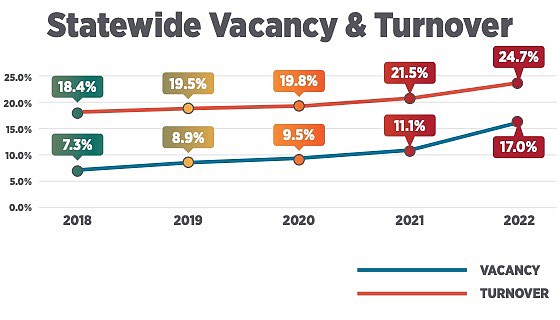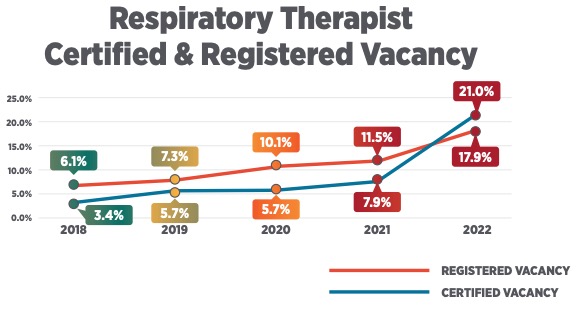Missouri's health leaders this week said, with "unprecedented levels of turnover and vacancy" in hospital staffing, current health care trends are not sustainable.
The annual Missouri Hospital Association (MHA) 2022 Workforce Report shows that "a perfect storm" of early retirements, job changes and moves to other professions are contributing to staffing shortages.
The challenges hospitals now face are profound, according to the MHA report.
Making matters worse, many nursing schools (Lincoln is an exception) are turning away prospective students because the schools don't have the staffing to meet full enrollment.
Hospitals have for years struggled with the ability to attract and retain staff.
Data from an annual MHA report show the COVID-19 pandemic may have exacerbated hospitals' challenges: Vacancies in staff nursing (key hospital positions) have doubled over the past five years.
According to the 2022 Workforce Report, the turnover rate for staff nurses in hospitals increased from 19.5 percent in 2019 to 24.7 percent in 2022. And, the positions' vacancy rate leapt from 8.9 percent in 2019 to 17 percent in 2022. It has increased 87 percent since 2020 and more than doubled since 2018, when the rate was 7.3 percent.
As of Friday, St. Mary's Hospital in Jefferson City has 73 nursing openings; the shifts include day/night/weekend, full time, part time, substitute and PRN or pro re nata or on-call nurses, said Janet Wear-Enloe, director of business development and marketing. The hospital also has six openings for respiratory therapists.
Travel staff fill in the gaps, Wear-Enloe said.
Capital Region Medical Center, like other area hospitals has several nurse openings, said Emily Mantle, director of marketing.
It has 41 open positions for registered nurses (and is filling 32 of those positions with agency registered nurses). Agency nurses are those provided by outside sources for hospitals in need of staff.
Vacancy rates are most troubling, MHA spokesman Dave Dillon said, although the "churn" represented by turnover is a big problem.
"In essence, vacancy means that despite looking for qualified candidates, there are none available," Dillon said. "There are some structural problems that pre-exist the pandemic -- the average nurse is a 50-something-year-old -- and that means that just as the later boomers begin to need care at a much higher level, a big portion of the workforce will be reaching retirement age."
The MHA said turnover and vacancy levels present immediate and long-term risks for care delivery and workforce sustainability. It describes challenges hospitals face as profound.
"The pandemic was highly disruptive to the hospital workforce," MHA President Jon Doolittle said in a news release. "As we exited 2021, the indications of a full-blown crisis in hospital staffing were emerging."
The annual report, he continued, points out that several front-line caregiver positions remain at record levels of vacancy. And, many jobs supporting hospital operations, such as housekeeping services or dietary aides, have "astronomical" rates of turnover.
The current trends are unsustainable, Doolittle said.
The workforce crisis is a top operational issue -- statewide and nationally -- according to the report.
The pandemic caused "significant disruption in the health care workforce," it states.
Registered nurses are the most-employed positions for hospitals in Missouri, according to the report. However, vacancies for those positions are the highest they've ever been since the MHA has reported the statistics, and stand at 19.8 percent this year (up 12 percent from 2021).
"Missouri has 33,692 nurses working in hospitals, and 8,334 vacant staff nurse positions," the report states.
Many are leaving the field, it said.
The report says a "perfect storm" of early retirements, job changes and exits for other professions has contributed to staffing shortages.
"Front-line health care workers are facing burnout after nearly two years of pandemic response," it states. "According to national research from McKinsey & Company, 32 percent of nurses indicated they may leave their current position, where they provide direct patient care, within the next year."
McKinsey & Company is a consulting firm established in Chicago in 1926 that advises on corporate and governmental strategic management.
On top of nurses considering changing their situations, the number of employees opting to become travel nurses during the pandemic reached record numbers.
"To meet the greatest demands, hospitals are working to reallocate and retrain nurses and other personnel," the report states. "Some hospitals are re-evaluating their skill mix -- working toward team-based and virtual care models, and fostering career ladders and professional development. In addition, they are using tools to recruit, retain and reward staff, including financial incentives, new flexibility and support systems within the workplace, and personal programs."
CRMC recently increased its minimum wage and implemented a 5 percent raise across the organization, Mantle said.
"Our goal is not only to hire great employees, but to retain our dedicated staff. During our high peak census, we were able to utilize the critical care skill set of paramedics, partnered with our highly skilled nursing staff, to care for (intensive care unit) patients," she said. "We're also looking to the future by working closely with nursing school programs on mutually beneficial partnerships."
CRMC will continue to think of inventive ways to overcome staffing challenges, and to deliver excellent care, Mantle said.
However, it is not only in nursing where shortages exist.
Cole is among 20 counties in Central Missouri MHA considers a Central Region (bordered on the north by Audrain, Boone and Howard counties and on the south by Dent, Laclede, Phelps and Pulaski counties).
Within that region, there are more than 1,670 people working in nurse assistant positions (care technicians, certified nurse assistants or unlicensed assistive personnel), according to the report. However, another 441 of these positions remain open in the region. And the turnover rate is 40.9 percent, which is equal to the state rate.
There has been growth in many fields within health care.
In 2020, area hospitals employed 100 full-time sterile processing technicians (whose job is to sterilize surgical instruments). In 2022, there are 124 such positions (including part-time positions, hospitals employ 137 people for the position). Twenty-eight of the positions remain open.
The positions that continue to be the most difficult to keep staffed are in housekeeping or food services, where employees turn over consistently at a rate higher than 40 percent.
Physicians remain in the positions with the least turnover. Statewide, there are only 1.5 percent of positions that are unfilled, according to the MHA report. And, only 14 employed physician positions are open (of 965 available).
Positions for occupational therapists, pharmacists and medical records coders also show little turnover.
The pipeline
The pandemic is affecting training for the health care workforce, according to the report.
"Schools are struggling to access essential clinical rotations for student training because of a lack of hospital staff. And increasing shortages of nursing faculty make it difficult of schools to accept all interested students," the report states.
The Missouri State Board of Nursing's 2020 annual report showed that even then, in the 90 state prelicensing nursing programs, at least 45 full-time and 44 part-time adjunct nurse faculty positions remained unfilled.
At that time, there were 10,424 students enrolled in nursing, but schools turned away 1,296 qualified applicants.
"The number of qualified applicants that cannot be accommodated is staggering," according to MHA report. "Missouri's nursing programs report that an additional 87 full-time faculty positions would be necessary to accommodate all applicants who are deemed qualified for admission."
On a side note, the report points out, at least 126 Missouri nurse educators plan to retire within the next five years.
Ann McSwain, an associate professor in the Lincoln University nursing department, said in an email to the News Tribune the university works with MHA and the American Association of Colleges of Nursing to study a snapshot of the expected demand for nursing graduates.
"The nursing shortage is not new," she said. "It is an ongoing problem, however, the pandemic has highlighted the need for qualified nursing faculty in the classroom and competent nurses at the bedside."
Educators have expected for years that when the Baby Boomers aged, the deficit in registered nurses would increase.
Aging Baby Boomers have created growth in comorbidities and long-term care needs, McSwain said. Those challenges also drive increased specialized health care needs.
Unlike many other nursing program, Lincoln's has not had to turn students away because of staffing shortages, McSwain said. However, as the institution admits students, it has to plan how many clinical instructors are needed based on how many students are in each clinical course.
"This has been challenging at times, as we've faced struggles with staffing ourselves," she said. "In addition, some of our specialized clinical sites only allow small students' groups, so that requires clinical instructors to have to schedule additional days to ensure all students get sufficient clinical experiences."
The university tries to maintain an excellent nursing education for students, while facing staffing challenges.
Nursing application numbers at Lincoln University tend to fluctuate, she said. And there is competition for the best students.
"We are glad to be back in area high schools (following the pandemic) to present at recruiting events," McSwain said.
However, nursing competes with other career options for high school graduates, who are carefully considering pay rates, work-life balance, potential for promotion and other factors that students may find attractive.


